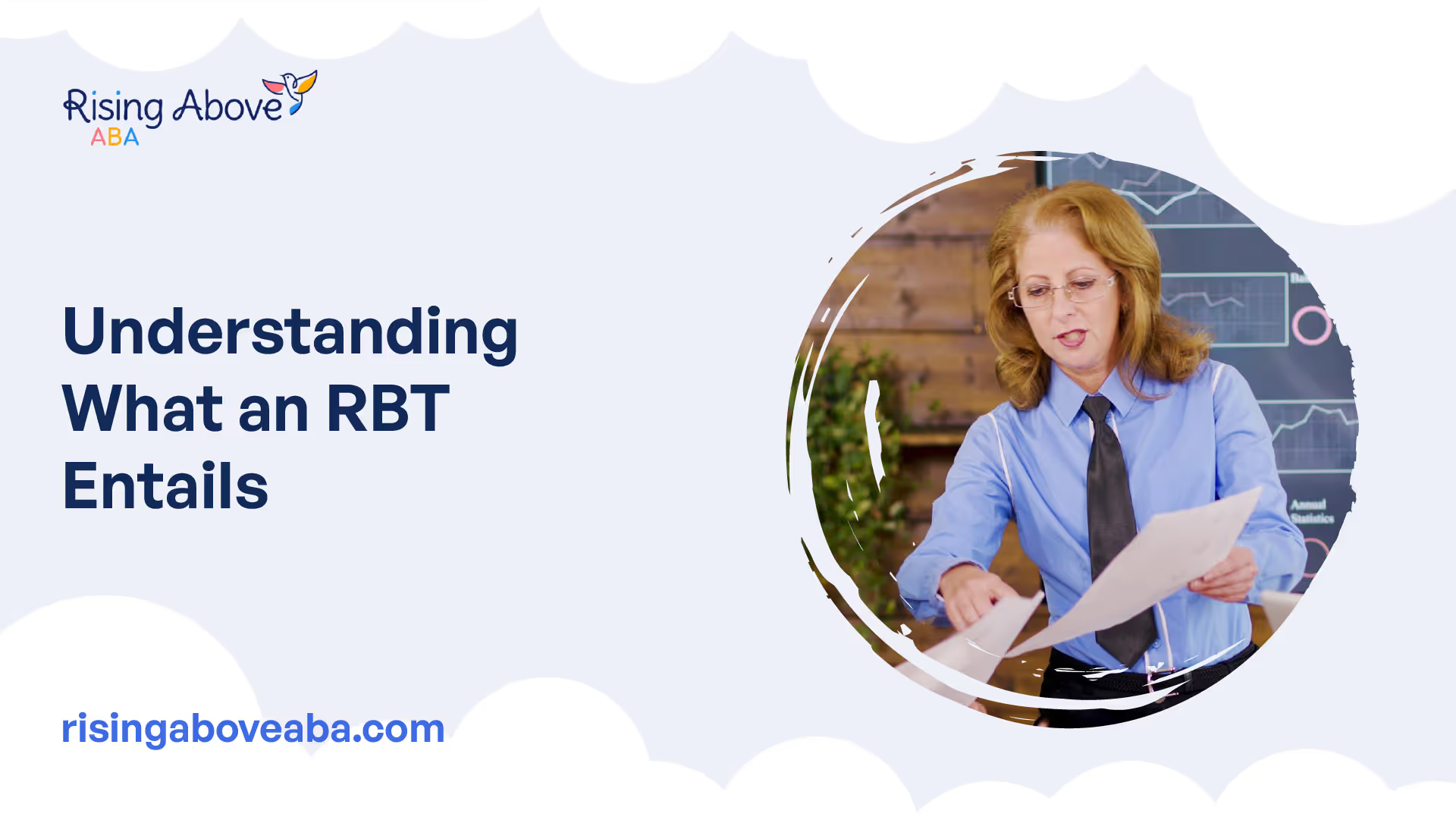Understanding What an RBT Entails
Discover the mystery of an RBT! Unveiling the role, responsibilities, and career opportunities in behavior analysis. Learn what an RBT entails today!

Understanding RBT Certification
To understand the role of a Registered Behavior Technician (RBT), it's important to first grasp the concept of RBT certification, the requirements, and the responsibilities associated with it.
What is an RBT?
RBT stands for Registered Behavior Technician, and it refers to a paraprofessional who practices under the close, ongoing supervision of a Board Certified Behavior Analyst (BCBA) or a Board Certified Assistant Behavior Analyst (BCaBA) [1]. RBTs play a vital role in the field of applied behavior analysis (ABA) and are responsible for directly implementing behavior-analytic services. They work closely with individuals with autism or other developmental disabilities to provide therapy, conduct assessments, and assist in skill development.

Role of an RBT
The primary responsibility of an RBT is to implement behavior-analytic services. They follow the guidance and direction of a supervising BCBA or BCaBA, who oversees their work and provides ongoing support and feedback. RBTs work directly with individuals, helping them acquire and maintain important life skills while reducing challenging behaviors.
RBTs collaborate closely with BCBAs to ensure effective treatment plans and intervention techniques. They actively participate in team meetings, sharing observations and data to inform decision-making and optimize therapy outcomes. By working under the supervision of a BCBA, RBTs contribute to the comprehensive care and support provided to individuals receiving ABA therapy.
RBT Supervision and Settings
RBTs practice under the close supervision of an RBT Supervisor and/or an RBT Requirements Coordinator. Supervision is a critical aspect of the RBT role, as it ensures the quality and effectiveness of services provided. Supervisors monitor the RBT's work, provide guidance, and offer ongoing training and support.
RBTs may provide services in various settings, including homes, schools, clinics, and communities. The diverse settings allow RBTs to adapt their skills to different environments and cater to the unique needs of individuals receiving ABA therapy. By delivering therapy in various settings, RBTs promote generalization of skills and support individuals in multiple facets of their lives.
Understanding the certification process, the role of an RBT, and the importance of supervision and settings helps clarify the responsibilities and expectations associated with being an RBT. RBTs play a crucial role in the implementation of behavior analysis services, supporting individuals with developmental disabilities, and working collaboratively with BCBAs and other professionals in the field of ABA therapy.
Becoming an RBT
If you are interested in becoming a Registered Behavior Technician (RBT), there are specific steps and requirements that you need to fulfill. This section will outline the eligibility requirements, training and competency assessment, and the certification process for becoming an RBT.
Eligibility Requirements
To be eligible for RBT certification, individuals must meet certain requirements. As of November 1, 2019, the Behavior Analyst Certification Board (BACB) mandates that individuals pursuing RBT certification must have a minimum of a high school diploma or equivalent. Meeting the minimum age requirement and having the necessary educational qualifications are the foundational eligibility criteria for becoming an RBT.
Training and Competency Assessment
Individuals aspiring to become RBTs must complete a 40-hour training program that covers the basics of Applied Behavior Analysis (ABA) therapy and the role of an RBT. This training is designed to equip individuals with the necessary knowledge and skills to provide quality services to clients under the supervision of a Board Certified Behavior Analyst (BCBA) or a Board Certified Assistant Behavior Analyst (BCaBA). The training program ensures that RBTs are well-prepared to implement behavior intervention plans and collect data accurately.
Following the completion of the training, individuals are required to pass a competency assessment. This assessment evaluates their ability to apply the principles and techniques learned during the training program in real-world scenarios. Successful completion of the competency assessment is a crucial step towards RBT certification.
Certification Process
Once the eligibility requirements have been met, and the training and competency assessment have been successfully completed, individuals can proceed with the certification process. The certification examination for RBTs is administered by the BACB. It is important to note that the certification examination can only be taken by individuals who have completed the required training and passed the competency assessment.
Upon passing the certification examination, individuals will officially become Registered Behavior Technicians. The RBT certification is recognized as a credential for providing high-quality services in the field of ABA therapy. It is important to note that RBT certification requires annual renewal through continuing education courses to ensure continuous learning and professional growth.
By completing the necessary training, passing the competency assessment, and obtaining RBT certification, individuals can embark on a rewarding career as a Registered Behavior Technician. The certification process ensures that RBTs have the knowledge, skills, and credentials to make a positive impact in the lives of individuals receiving ABA therapy.
Responsibilities of an RBT
As a Registered Behavior Technician (RBT), individuals have specific roles and responsibilities in the field of applied behavior analysis (ABA) therapy. These responsibilities include implementing behavior intervention plans, collecting data and reporting progress, and collaborating with Board Certified Behavior Analysts (BCBAs) or Board Certified Assistant Behavior Analysts (BCaBAs) to ensure effective treatment. Let's explore each of these responsibilities in more detail.
Implementing Behavior Intervention Plans
A primary responsibility of an RBT is to implement behavior intervention plans under the supervision of a BCBA or BCaBA. These plans are developed by the supervisor and are tailored to the individual's needs. RBTs work directly with individuals diagnosed with Autism Spectrum Disorder or other developmental disabilities, providing one-on-one support in various settings such as clinics, hospitals, schools, mental health facilities, or their own homes [3].
RBTs follow the treatment plans developed by their supervisor, which may include teaching new skills, promoting desired behaviors, and reducing harmful or disruptive behaviors. They implement specific strategies and techniques to help individuals achieve their goals and improve their quality of life. Through their direct implementation of behavior-analytic services, RBTs play a vital role in supporting individuals in their behavioral development.
Collecting Data and Reporting Progress
Accurate data collection is an essential responsibility of an RBT. They collect data on the individual's progress and behavior, recording specific details based on the behavior intervention plan. This data helps evaluate the effectiveness of the treatment plan and guides decision-making by the BCBA or BCaBA [3]. By maintaining detailed records and documenting observations, RBTs contribute to the ongoing assessment and modification of treatment strategies.
RBTs collaborate with BCBAs or BCaBAs to ensure that data collection methods are consistent and reliable. They report progress and share data with the supervisor, enabling them to make informed decisions about the individual's treatment plan. This collaborative approach ensures that interventions are continually refined and adjusted based on the observed progress and outcomes.
Collaborating with BCBA or BCaBA
RBTs work closely with BCBAs or BCaBAs to provide effective ABA therapy. They collaborate with these supervisors to ensure the successful implementation of behavior intervention plans and receive ongoing guidance and support. RBTs follow the instructions and recommendations provided by the supervisor, seeking clarification when needed and reporting any concerns or challenges that arise during sessions.
This collaboration also involves regular communication between the RBT and the supervisor. RBTs share important information, observations, and updates on the individual's progress. This exchange of information allows the supervisor to stay informed about the individual's needs and make necessary adjustments to the treatment plan to ensure optimal outcomes.
By working in tandem with BCBAs or BCaBAs, RBTs contribute to a comprehensive and coordinated approach in delivering ABA therapy. Their collaboration ensures that the individual receives consistent and cohesive support throughout their treatment journey.
Understanding the responsibilities of an RBT is essential for individuals considering or pursuing a career in ABA therapy. By implementing behavior intervention plans, collecting data, and collaborating with supervisors, RBTs play a crucial role in supporting individuals with developmental disabilities and making a positive impact on their lives.
Career Opportunities for RBTs
Registered Behavior Technicians (RBTs) have a range of career opportunities available to them within the field of behavior analysis. Their vital role in implementing evidence-based interventions and strategies to help individuals learn new skills and improve their quality of life positions them as essential members of the behavior analysis team.
Career Advancement in Behavior Analysis
The role of an RBT offers opportunities for career enhancement and progression. The expertise and hands-on experience gained as an RBT serve as valuable stepping stones towards roles such as a Board Certified Assistant Behavior Analyst (BCaBA) or a Board Certified Behavior Analyst (BCBA). These positions indicate a dynamic profession that evolves and offers continuous learning and upward mobility.
Transitioning to BCBA
Transitioning from an RBT to a BCBA requires fulfilling certain educational and fieldwork milestones. This typically involves obtaining a master's degree in behavior analysis or a related field. The practical experience gained as an RBT is invaluable in preparing individuals to thrive as a BCBA. This transition aligns with the goal of making meaningful contributions to the lives of those with behavioral disorders and further expanding one's career in behavior analysis.
Impact of RBT Work
Despite the challenging nature of the work, the role of an RBT offers the opportunity to make a significant impact on the lives of individuals. RBTs contribute to improving the quality of life for their clients, such as aiding autistic children in developing effective communication skills and supporting them in achieving a more independent lifestyle. Through their dedication and expertise, RBTs facilitate meaningful change in the lives of others.
As RBTs gain experience and expand their knowledge in the field of behavior analysis, they open doors to various career paths and make a positive difference in the lives of individuals with behavioral disorders. The continuous learning and growth opportunities within the profession contribute to the rewarding nature of being an RBT.
The Importance of RBT Certification
RBT certification holds significant importance in the field of Applied Behavior Analysis (ABA) therapy. Let's explore why it is considered a vital credential.
Professional Standards in ABA Therapy
The RBT certification is a widely recognized credential established by the Behavior Analyst Certification Board (BACB) to ensure that individuals providing ABA therapy adhere to professional, therapeutic, and ethical standards. This certification process plays a crucial role in maintaining high standards of care in ABA therapy.
Recognized Credential for Quality Services
The RBT certification acts as a recognized credential for individuals working in the field of ABA therapy. It signifies that an individual has met specific competency requirements and has the necessary skills to deliver quality behavioral services to individuals with special needs [7].
Continuous Learning and Growth
Earning the RBT certification involves completing a 40-hour training program, passing a competency assessment, and meeting specific eligibility criteria. This rigorous process ensures that RBTs are well-equipped with the knowledge and skills to provide effective behavioral services. Additionally, RBTs are encouraged to engage in ongoing professional development and continuous learning to further enhance their expertise in the field.
By obtaining the RBT certification, individuals demonstrate their commitment to delivering evidence-based interventions and improving the lives of individuals with special needs. It serves as an entry-level credential that opens up various career opportunities in the field of ABA therapy. Furthermore, it can serve as a stepping stone for those interested in advancing their careers in behavior analysis and pursuing higher-level certifications, such as becoming a Board Certified Behavior Analyst (BCBA).
In summary, RBT certification ensures adherence to professional standards, provides a recognized credential for quality services, and promotes continuous learning and growth in the field of ABA therapy. Aspiring and practicing RBTs can benefit from the knowledge and skills gained through the certification process, making a positive impact on the lives of individuals with special needs.
References
- [1]: https://www.bacb.com/rbt
- [2]: https://centralreach.com/blog/rbt-certification/
- [3]: https://www.songbirdcare.com/articles/rbt-job-description
- [4]: https://www.bridgecareaba.com/blog/what-is-an-rbt
- [5]: https://mebefamily.com/the-perks-of-being-a-registered-behavior-technician/
- [6]: https://www.wethriveaba.com/resources/what-is-a-rbt/
- [7]: https://www.connectncareaba.com/rbt-certification

Compassion. Communication. Positivity. Professionalism
Give us a call at 888.572.7473 or reach out to our team online to get started—we're looking forward to partnering with your family.
Latest articles






Reach Out to Rising Above ABA

Most commercial insurance accepted
Contact us for any questions regarding coverage or plans – we’ll be happy to provide you with the clear guidance as to your best options.


